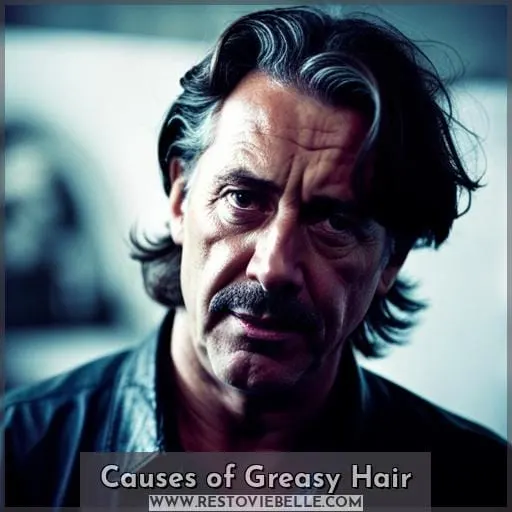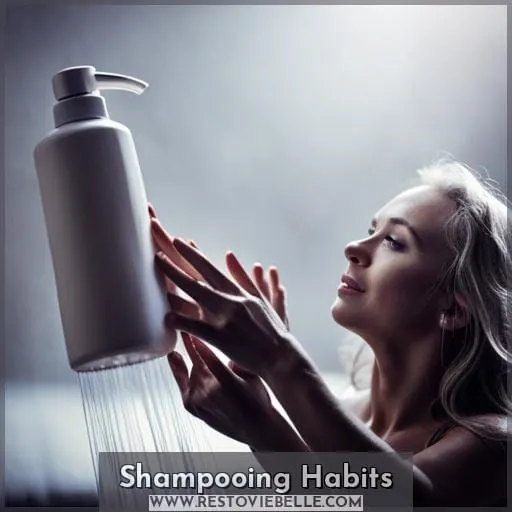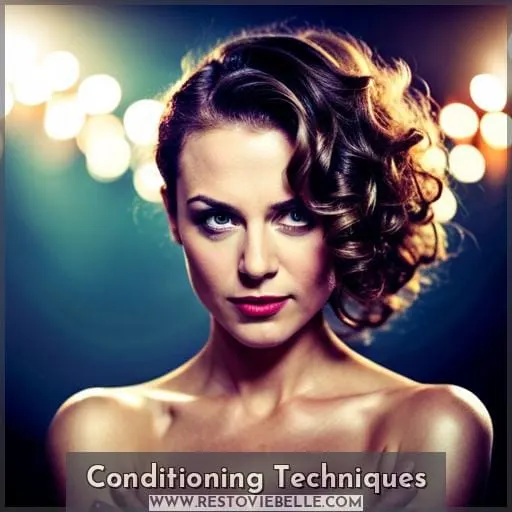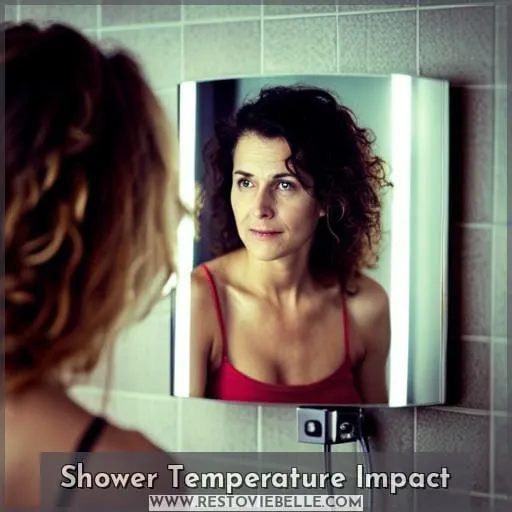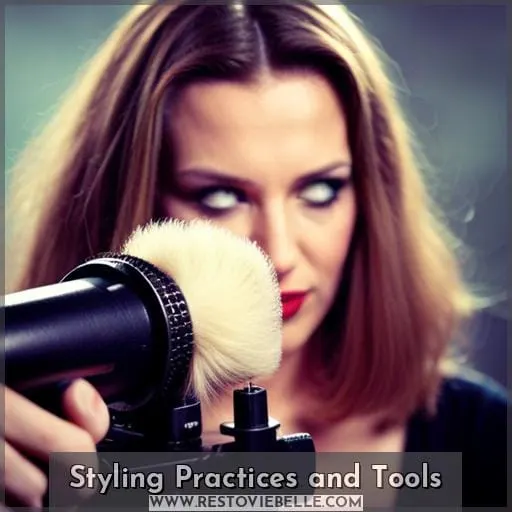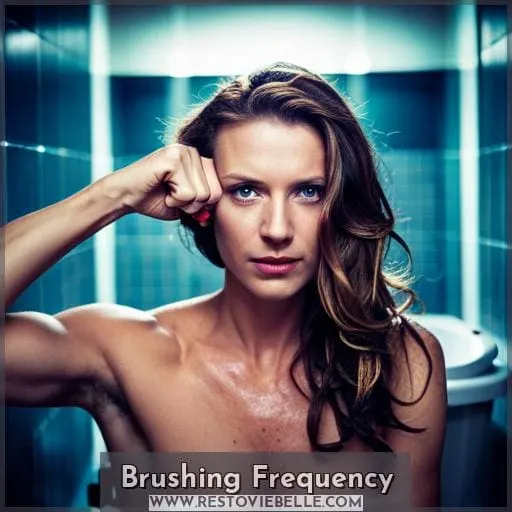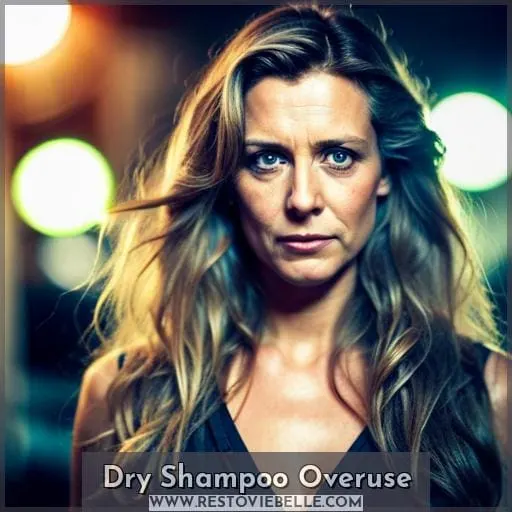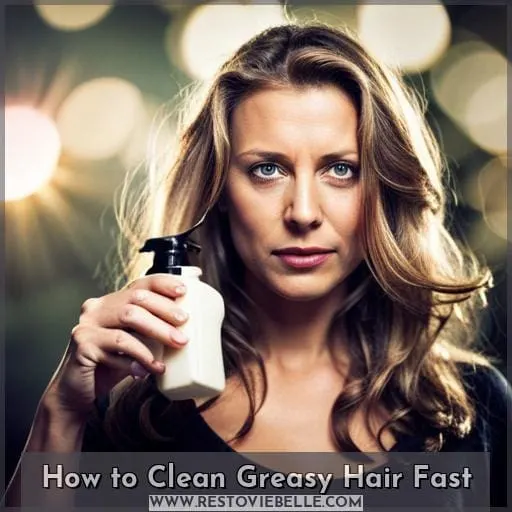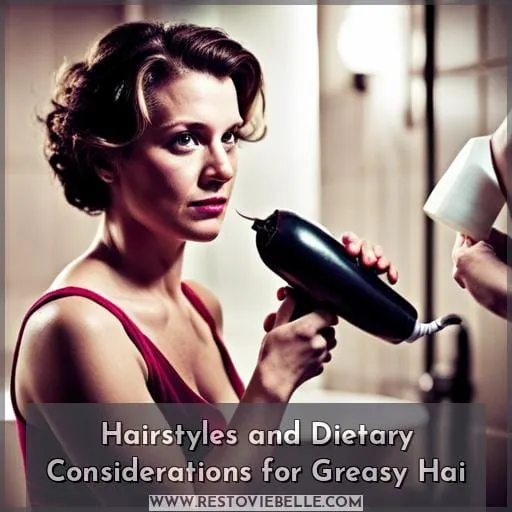This site is supported by our readers. We may earn a commission, at no cost to you, if you purchase through links.
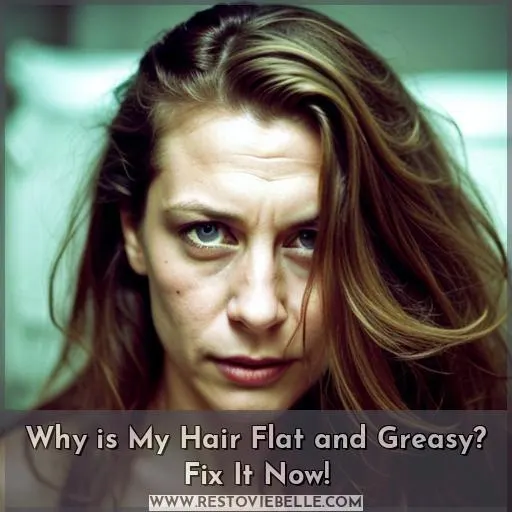 Imagine waking up every morning to flat, greasy hair that refuses to cooperate. It’s frustrating and can make you feel self-conscious.
Imagine waking up every morning to flat, greasy hair that refuses to cooperate. It’s frustrating and can make you feel self-conscious.
In this article, we’ll explore the reasons why your hair is flat and greasy and provide expert tips on how to fix it. From proper shampooing techniques to styling practices and dietary considerations, we’ve got you covered.
Say goodbye to limp locks and hello to voluminous, healthy-looking hair!
Table Of Contents
- Key Takeaways
- Causes of Greasy Hair
- Shampooing Habits
- Conditioning Techniques
- Shower Temperature Impact
- Styling Practices and Tools
- Brushing Frequency
- Dry Shampoo Overuse
- How to Clean Greasy Hair Fast
- Hairstyles and Dietary Considerations for Greasy Hai
- Frequently Asked Questions (FAQs)
- How can I prevent my hair from becoming flat and greasy?
- What are some common mistakes people make when shampooing and conditioning their hair?
- Can the temperature of my shower impact the greasiness of my hair?
- Are there any specific styling practices or tools that can help add volume to flat and greasy hair?
- Are there any dietary considerations or specific hairstyles that can help manage greasy hair?
- Conclusion
Key Takeaways
- Excessive sebum production and improper shampooing techniques can contribute to flat and greasy hair.
- Styling practices like straightening hair too often and using dirty hair styling tools can make hair appear flat and greasy.
- Certain hairstyles and dietary considerations, such as upside-down drying and consuming refined sugars, can contribute to flat and greasy hair.
- Quick fixes like using purifying shampoo, apple cider vinegar treatment, and dry shampoo can help combat flat and greasy hair.
Causes of Greasy Hair
Excess sebum production, improper shampooing techniques, and the impact of styling products are common causes of greasy hair.
When your scalp produces too much oil, it can make your hair look flat and lifeless.
Using the wrong shampoo or not rinsing thoroughly can also contribute to greasiness.
Additionally, certain styling products that contain heavy oils or creams can weigh down your hair and make it appear greasy.
Understanding these causes will help you take steps to address them and achieve healthier-looking hair.
Excess sebum production
If your hair is flat and greasy, it may be due to an overproduction of sebum by your scalp’s sebaceous glands. Excess sebum production can lead to oily hair that lacks volume and appears weighed down.
This condition can be influenced by hormonal factors, such as puberty or menopause, as well as dietary choices high in fats and sugars.
Properly regulating sebum production through effective cleansing techniques and lifestyle adjustments can help improve scalp health and restore balance to your hair texture.
Improper shampooing techniques
When you don’t shampoo your hair properly, it can lead to greasy and flat locks.
Proper rinsing is essential to remove all traces of shampoo from your hair, as leftover residue can contribute to oiliness.
Controlling sebum production starts with using the right water temperature for your hair wash – lukewarm water is best.
Incorporating clarifying products into your routine helps eliminate buildup that weighs down the hair.
Additionally, try volumizing techniques like upside-down drying and using lightweight styling products for added lift and fullness.
Impact of styling products
Styling products can contribute to greasy hair by adding excess oils and weighing down the strands.
Product residue from gels, mousses, serums, and creams can build up on the scalp, leading to oiliness.
Additionally, using dirty styling tools can transfer oils and dirt onto the hair.
Styling mistakes such as overusing heat tools or applying too much product can also result in greasiness.
It’s important to practice proper tool hygiene, choose lightweight products suitable for your hair type, and avoid excessive use of heat styling tools for healthier-looking locks.
Shampooing Habits
Are you struggling with flat and greasy hair? One possible reason could be overwashing or not shampooing enough.
Overwashing your hair can strip it of its natural oils, leading to increased oil production as a compensatory response.
On the other hand, not shampooing enough allows oil, dead skin cells, and debris to build up on the scalp, making your hair appear flat and greasy.
Finding the right balance in your shampooing habits is key to maintaining healthy-looking locks.
Overwashing
You may be overwashing your hair if it feels flat and greasy.
Overwashing, or washing your hair too frequently, can strip the scalp of its natural oils, leading to increased oil production as a compensatory response.
To maintain scalp health and prevent excess grease, it’s important to find the right balance in your shampooing habits.
Consider adjusting the frequency of washes based on factors such as:
- Scalp health
- Water temperature during showers
- Daily routine activities that may contribute to oil buildup (such as exercise)
- Product selection for gentle cleansing without stripping essential oils from the hair strands
- Incorporating volumizing techniques into your styling routine for added lift and body.
Not Shampooing Enough
If you’re noticing that your hair is flat and greasy, it might be because you’re not shampooing enough.
Proper shampooing habits are essential for maintaining healthy, voluminous hair.
Start by ensuring the water temperature is warm, but not too hot as it can strip away natural oils from your scalp.
When shampooing, take the time to massage your scalp gently with your fingertips to stimulate blood flow and remove excess oil buildup.
Additionally, incorporating clarifying products into your routine once a week can help eliminate any residue or product buildup that may be weighing down your strands.
Remember to consider environmental factors such as pollution and humidity when determining how often to wash your hair.
Conditioning Techniques
Are you wondering why your hair is flat and greasy?
One possible reason could be that you’re applying conditioner incorrectly.
It’s important to avoid applying conditioner on the roots of your hair, as this can contribute to greasiness.
Instead, focus on applying conditioner only on the ends of your hair for optimal results.
Applying Conditioner Incorrectly
Improper conditioner application can contribute to flat and greasy hair. To ensure your locks stay voluminous and grease-free, follow these conditioner tips:
- Focus on the ends: Apply conditioner from mid-lengths to ends only, avoiding the roots.
- Maintain moisture balance: Over-conditioning can lead to excess oiliness, so use a lighter conditioner or apply sparingly near the roots.
- Boost volume with styling products: Use volumizing sprays or mousses before drying your hair for added lift.
- Experiment with hairstyles like buns or braids that can help disguise greasy roots while adding texture.
Only Applying Conditioner on the Ends of Hair
When conditioning your hair, it’s important to avoid only applying conditioner on the ends of your hair. This common practice can make hair dry and lead to split ends. Additionally, it can weigh hair down and make it look limp.
To ensure proper conditioning techniques that promote healthy hair, focus on distributing conditioner evenly from mid-lengths to ends while avoiding the roots. This will help maintain a balance of moisture without making your strands greasy or heavy.
Remember that proper application of conditioner plays a crucial role in maintaining overall hair health and preventing damage such as breakage or split ends.
| Conditioner Tips |
|---|
| Distribute evenly from mid-lengths to ends |
| Avoid applying near roots |
| Prevents dryness and split-ends |
Shower Temperature Impact
Take note of the impact that shower temperature has on your flat and greasy hair.
The temperature of your showers can play a significant role in the health and appearance of your hair.
- Hot Showers: Hot water can strip away natural oils from your scalp, leading to dryness and potential overproduction of oil as a compensatory response.
- Cold Rinse Benefits: A final rinse with cold water helps seal the hair cuticle, adding shine and reducing frizz. It also promotes scalp health by constricting blood vessels, which can help reduce inflammation or irritation.
- Environmental Impact: Using hot water for extended periods not only affects our own skin but also contributes to energy waste and higher carbon emissions.
- Straightening Effects: If you frequently straighten or style your hair using heat tools like flat irons or curling wands, hot showers may exacerbate damage caused by these styling practices.
By adjusting the shower temperature accordingly, you can minimize dryness while maintaining healthy levels of scalp oil production. Consider incorporating a cold rinse into your routine for added benefits to both environmental conservation efforts as well as improving overallhair health.
Styling Practices and Tools
Now let’s talk about some styling practices and tools that may be contributing to your flat and greasy hair.
One common culprit is straightening your hair too often, as this brings the strands closer to the scalp, increasing contact with oils.
Additionally, using dirty hair styling tools can transfer oils and dirt onto your freshly washed hair, leading to greasiness.
Straightening Hair Too Often
To prevent flat and greasy hair, avoid straightening your hair too often.
While using a straightener can give you sleek and smooth locks, excessive use can lead to various issues such as heat damage, hair loss, hair breakage, split ends, scalp irritation, dandruff, frizz and flyaways.
The high heat from the straightener strips the natural moisture from your strands leaving them dry and prone to damage.
Additionally, hair that’s constantly subjected to the intense heat of a straightener loses its shine over time, resulting in dullness.
It’s important to balance styling practices with proper care for healthy-looking tresses.
Dirty Hair Styling Tools
Clean your hair styling tools regularly to prevent greasy buildup and maintain healthy, voluminous locks.
- Clean brushes weekly: Remove any hair or debris from your brushes and combs using a fine-toothed comb or a cleaning brush.
- Avoid using the hair dryer excessively: Excessive heat can lead to oil production on the scalp, causing greasiness.
- Limit dry shampoo usage: While dry shampoo is convenient for absorbing excess oil, overuse can result in product buildup and dullness.
- Watch out for hairspray residue: Hairspray residue not only weighs down your strands but also attracts dirt and grease.
By following these practices, you’ll ensure that your styling tools remain clean and free from any build-up that could contribute to flat, greasy hair.
Brushing Frequency
How often should you brush your hair to avoid flat and greasy locks?
Brushing frequency plays a crucial role in maintaining healthy, voluminous hair. While brushing helps distribute natural oils from the scalp to the ends of your strands, overdoing it can lead to excessive oil production and limpness. To strike a balance, dermatologists recommend brushing before washing your hair as part of your pre-shower routine.
When it comes to choosing the right brush for avoiding flat and greasy hair, opt for a boar bristle brush. Its gentle bristles help distribute sebum evenly while reducing frizz. Additionally, try brushing in sections instead of running through all your hair at once; this method ensures thorough coverage without stimulating excess oil production.
In terms of technique, dry brush lightly rather than vigorously tugging on knots or snags which can damage both scalp health and overall quality of the strands themselves.
To maintain fresh-looking locks throughout the day without adding extra grease or weight,
incorporate these lifestyle tips into daily routines:
- Avoid over-brushing: Stick with once-daily sessions
- Keep up with regular trims:
- Freshly cut ends appear healthier
- Dry shampoos work wonders when pressed gently onto roots
Remember that everyone’s unique needs may require some experimentation in order find what works best for them individually; therefore consulting with professionals is always recommended
Dry Shampoo Overuse
If you’re relying on dry shampoo too heavily, it may be contributing to your flat and greasy hair.
Dry shampoo is a popular product used to absorb excess oil and refresh the hair between washes. However, overusing dry shampoo can lead to buildup on the scalp, causing irritation and flaking. This buildup not only weighs down your hair but also prevents proper airflow to the scalp, which can result in issues like clogged follicles and even potential hair loss.
When dry shampoo is applied excessively or without thorough removal, it forms a layer of product buildup on both the scalp and strands of hair. This build-up traps dirt, oil, sweat particles as well as dead skin cells that naturally shed from our scalps over time creating an unfavorable environment for healthy-looking locks.
To avoid these issues caused by excessive use of dry shampoos:
- Limit usage: Reserve use for days when washing isn’t possible.
- Proper application: Apply at least 6 inches away from roots.
- Thoroughly brush out: Use a natural bristle brush or comb through after applying.
- Regular cleansing routine: Ensure regular washing with clarifying shampoos that effectively remove any residual product build-up.
By following these steps along with proper maintenance practices such as regular washing with appropriate products designed for your specific needs will help maintain optimal scalp health while preventing flatness due to grease accumulation.
How to Clean Greasy Hair Fast
If you’re dealing with greasy hair and need a quick solution, there are a few effective methods to clean your hair fast.
One option is to use a purifying shampoo specifically designed for greasy hair, which can help remove excess oil and buildup.
Another method is an apple cider vinegar treatment, where you mix equal parts water and apple cider vinegar and apply it to your scalp before rinsing thoroughly.
Lastly, dry shampoo can be used as a quick fix by absorbing the oils in your hair without needing water or traditional washing.
Purifying Shampoo for Greasy Hair
To quickly clean greasy hair, reach for a purifying shampoo that effectively removes excess oils and buildup.
Look for dry shampoo brands specifically formulated to combat greasiness and refresh your locks in between washes.
When choosing a clarifying shampoo, consider its benefits compared to other types of shampoos such as dandruff or volumizing options.
Clarifying shampoos are designed to deeply cleanse the scalp and remove product residue, while also helping control oil production without stripping the hair of essential moisture.
Apple Cider Vinegar Treatment
To combat greasy hair quickly, try an effective apple cider vinegar treatment.
Apple cider vinegar works by balancing the pH level of your scalp, reducing excess oil production and leaving your hair feeling clean and refreshed.
You can use apple cider vinegar once or twice a week as a rinse after shampooing to see results. However, be cautious of potential side effects such as scalp irritation or dryness.
Additionally, apple cider vinegar has been known to promote hair growth and help with dandruff issues.
- Balances pH levels on the scalp
- Reduces excess oil production
- Promotes healthy hair growth
Dry Shampoo as a Quick Fix
To quickly clean greasy hair, grab a bottle of dry shampoo and give your locks a much-needed refresh. Dry shampoo is an excellent quick fix for oily hair, especially when you don’t have time to wash it.
It absorbs excess oil and adds volume to flat strands. Simply spray the dry shampoo onto your roots, wait a few minutes for it to absorb the oil, then brush or massage it through your hair. You can also use baby powder or cornstarch as alternatives if you don’t have dry shampoo on hand.
| Pros | Cons |
|---|---|
| Absorbs excess oil | Can leave residue |
| Adds volume and texture | Not suitable for all hair types |
Dry Shampoo vs Co-wash:
- Dry shampoo helps remove oil from the scalp without water.
- Co-washing involves using conditioner instead of traditional shampoos.
Dry Shampoo vs Shampoo:
- Traditional shampoos cleanse by removing dirt, oils,
and product buildup with water.
- Dry shampoos refreshes between washes without
water.
Using dry shampoo correctly is essential for optimal results:
- Start with unwashed (oily)hair
2.Spray/apply evenly at roots
3.Massage/rub in
4.Brush/style as desired
For fine-haired individuals who struggle with flatness due to excessive sebum production throughout the day: try using volumizing products after applying dry shampoo.
A bun or braid are great hairstyles that help disguise greasiness; simply twist up into either style while incorporating some extra texture from fresh application of dry shampoo.
Hairstyles and Dietary Considerations for Greasy Hai
Now let’s discuss some effective hairstyles and dietary considerations to combat greasy hair.
By choosing the right hairstyles, such as upside-down drying or using large barrel brushes for added volume at the roots, you can create a fuller appearance that disguises flatness.
Additionally, incorporating a balanced diet with plenty of fruits and vegetables while limiting oily and greasy foods can help regulate sebum production in your scalp for healthier-looking hair.
Shampoo frequency and type.
You should adjust your shampoo frequency and choose the right type of shampoo for greasy hair to combat flatness and oiliness.
- Shampoo every 2-3 days: Washing too frequently can strip the scalp of its natural oils, leading to increased oil production.
- Condition mid-lengths and ends: Avoid applying conditioner near the roots as it can weigh down your hair.
- Use clarifying shampoo weekly: This helps eliminate excess oils and product buildup from your scalp.
- Cold rinse: Finish off with a cold water rinse to close the cuticles, adding shine and promoting a healthier scalp.
Properly caring for greasy hair involves more than just adjusting your washing routine – it also includes choosing products that will help control oiliness while providing essential nutrients for healthy locks.
Shampooing Habits:
- To combat flatness caused by oily roots, aim to wash your hair every 2-3 days using a gentle yet effective cleanser like Pantene Agedefy Shampoo or LivSo Scalp Shampoo. These shampoos target specific concerns such as aging signs or dryness while still maintaining overall cleanliness.
Conditioning Techniques:
- When conditioning greasy locks, focus on applying conditioner only on mid-lengths through ends rather than near the roots. This prevents unnecessary weight at our scalps which may lead us straight back into undesired limp territory.
Shower Temperature Impact:
- Consider finishing off each shower session with a cold water rinse. The colder temperature helps seal in moisture while reducing frizz; this contributes significantly towards preventing an overly oily appearance due both pre-existing sebum levels & environmentally induced factors impacting daily living conditions.
Styling Practices and Tools:
- To add volume to your hair, opt for volumizing styling products such as mousse or sprays that provide lift at the roots. Be mindful of using lighter alternatives to prevent weighing down your locks. Additionally, incorporating upside-down drying techniques with large barrel brushes can help increase root volume while experimenting with Velcro rollers post-blow-drying adds an extra boost of fullness.
By adjusting your shampoo frequency and choosing the right type of shampoo for greasy hair, you can combat flatness and oiliness effectively. Incorporate these tips into your hair care routine along with other strategies like conditioning mid-lengths through ends only, using clarifying shampoos weekly, finishing off with a cold rinse after each shower session, and utilizing volumizing styling products.
Conditioning techniques and placement.
Revitalize your greasy hair by reevaluating your conditioning techniques and strategically placing conditioner to achieve volume and manageability.
When it comes to conditioning, it’s important to avoid roots as this can contribute to product buildup and greasiness. Instead, focus on applying conditioner from the mid-lengths of your hair down to the ends.
This will help maintain scalp health while keeping your hair nourished without weighing it down.
Additionally, rinsing with cold water after conditioning can help seal the cuticle for added shine and promote overall scalp health.
| CONDITIONING TECHNIQUES | PLACEMENT |
|---|---|
| Avoid roots | Mid-lengths of hair down |
Styling for volume
For added volume and bounce, consider incorporating different hairstyles and dietary considerations into your routine.
- When blow-drying your hair, try using the upside-down technique to increase root volume.
- Use styling products that contain proteins for added body and fullness.
- Consider getting a haircut with a blunt cut, as this can instantly create more volume.
- Chemical processes like coloring or perming can also add volumizing effects to the hair.
- Additionally, opt for volumizing shampoos that are specifically designed for body building purposes.
Frequently Asked Questions (FAQs)
How can I prevent my hair from becoming flat and greasy?
To prevent flat and greasy hair, establish a regular washing routine with a mild shampoo that controls sebum.
Focus conditioner on the mid-lengths to ends only.
Utilize volumizing styling products and techniques like upside-down drying for added volume.
What are some common mistakes people make when shampooing and conditioning their hair?
To prevent flat and greasy hair, avoid common shampooing and conditioning mistakes.
- Don’t over-shampoo.
- Don’t use heavy conditioners on roots.
- Thoroughly rinse to remove residue.
- Focus conditioner on mid-lengths to ends for volume without weighing down the roots.
Can the temperature of my shower impact the greasiness of my hair?
The temperature of your shower can impact the greasiness of your hair.
Hot showers can dry out the scalp, leading to increased oil production.
Opt for a medium-warm temperature and finish with a cold rinse for healthier, less greasy hair.
Are there any specific styling practices or tools that can help add volume to flat and greasy hair?
To add volume to flat, greasy hair, try using:
- A root-lifting spray or mousse
- Blow-drying upside down
- Large barrel brushes for extra lift at the roots
- Velcro rollers post-blow-drying
- A lightweight holding hairspray for lasting fullness.
Are there any dietary considerations or specific hairstyles that can help manage greasy hair?
To manage greasy hair, consider dietary adjustments like:
- Reducing refined sugars
- Increasing omega-3 fatty acids
Opt for hairstyles that promote airflow to the scalp, such as:
- Loose braids
- Ponytails
Conclusion
Say goodbye to your flat and greasy hair woes! By understanding the causes and implementing simple changes, you can achieve voluminous and healthy-looking locks.
Proper shampooing techniques, conditioning methods, and adjusting shower temperature can make a significant difference.
Be mindful of your styling practices and tools, and avoid over-brushing and overusing dry shampoo.
If you need a quick fix, try a purifying shampoo, an apple cider vinegar treatment, or dry shampoo.
Additionally, consider your hairstyles and dietary choices for greasy hair.
Embrace the solutions and say hello to fabulous hair every day!
